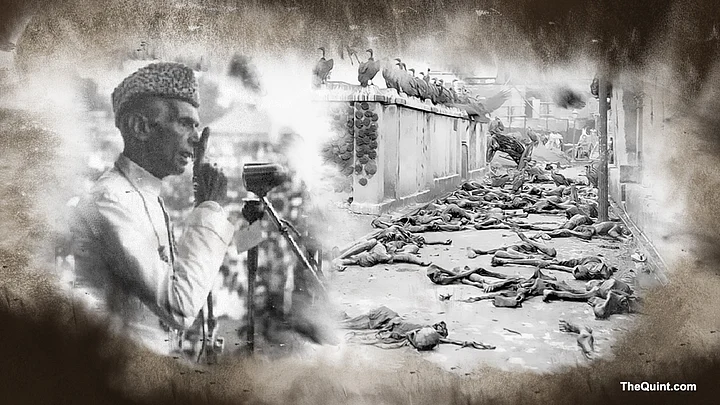“Larke lenge Pakistan.” (We’ll fight to get Pakistan.)
“...this is the time we have to retaliate, and you have to answer brutality with brutality.”
These sentences spoken by a Muslim and a Hindu, respectively, in Kolkata on the morning of 16 August 1946 serve as ominous harbingers of what the day would bring with itself. Now known as the ‘Direct Action Day’ or The Great Calcutta Killings, 16 August poised itself right next to perhaps one of the most important days in Indian history, the day of the country’s Independence on 15 August, a year later. But unlike the latter, the former stands for an unprecedented spectacle of hatred and bloodshed.
In 1946, Muhammad Ali Jinnah declared 16 August as ‘Direct Action Day’ and called for Muslims all over the country to ‘suspend all business’. This was to put pressure on the British government to relent to the Muslim League’s (headed by Jinnah) demand of dividing the country on the basis of religion, thereby allowing the creation of a Muslim-dominated Pakistan.
The Situation in Bengal
The state of Bengal was one of those very few pockets in the country where Muslims were a majority. However, they were precariously positioned against a political hinterland inhabited by the Hindu-dominated National Congress, the Communist Party of India and the Hindu Mahasabha.
Additionally, as the freedom struggle against the colonial masters waged on, notions of nationalism became more intricately entwined with religion. Being an Indian started being equated with being a Hindu. However, the idea was to only assert the Indian identity against the European coloniser.
Writings of several thinkers, especially in Bengal, borrowed heavily from religious imagery and symbolism. These included names like Aurobindo Ghosh, Swami Vivekananda and Bankimchandra Chattopadhyay.
Perhaps, initially, the intention was not to alienate Muslims, but to find a coherent, firm voice against the British. Unfortunately, it did indeed serve to deepen the chasm between Hindus and Muslims.
The Day of the Great Calcutta Killings
The communal riots of 16 August 1946 are one of the most brutal incidents of violence in the history of India, leaving behind several hundred people, mostly Muslims, dead in its wake.
“...if we heard one murder has taken place we committed ten more... the ratio should be one to ten, that was the order to my boys,” said Gopal Pantha.
There are two sides of this story, however. When Jinnah called for a nationwide day of suspension of all business, he perhaps did not expect a riot as massive as the one which eventually took place.
The other side of the historical spectrum disagrees. The riots were a result of the panic Muslims experienced at the prospect of being a minority in a Hindu dominated country. In that case, it might have been a deliberate, well-thought scheme of executing the killings. It is hard to conclude that the violence, of a level as great as this one, and of a communal nature, was entirely unplanned.
The riots did eventually serve to increase a feeling of alienation among Muslims, therefore strengthening their desire for a separate nation. The violence made both communities realise the extent of harm they were capable of causing each other when being ‘forced’ to live together.
“‘One murder would fetch ten rupees and a wounding would bring five”, said Jugal Chandra Ghosh to his boys. “I saw four trucks standing, all with dead bodies, piled at least three feet high; like molasses in a sack, they were stacked on the trucks, blood and brain oozing out...”
Result of a Turbulent Political Front
The partition of Bengal in 1905 had resulted in the development of a Muslim consciousness. The formation of the Muslim League in 1906 further accentuated the manner in which religion got tied down with politics and the struggle for power.
Calcutta (now Kolkata) and its surrounding areas were hit by a series of riots over the next couple of years, starting from 1918 to 1930. In 1932, the British government allowed for the Communal Award, which granted separate electorates to the minorities.
The Award turned out to be very controversial and was criticised by many, including Mahatma Gandhi, who believed it would only serve to divide society further.
Finally in March 1946, the state elections resulted in the National Congress, the main opponent of the Muslim League, securing 86 seats as opposed to the League’s 114.
Muslims and Hindus who had presented a picture of unity and harmony in 1905 when they had unanimously protested against the partition of Bengal, now ended up with recurrent violent clashes over issues pertaining to idolatory, playing music and consumption of beef.
Aftermath of the Violence
‘Direct Action Day’ marked the beginning of several acts of violence spread over a couple of days in what came to be known as the Week of the Long Knives. While it was ostensibly established none of the politicians had expected the violence to reach as massive a scale as it did, it went ahead to become a brutality-ridden microcosm of the political struggle that had the entire country in its throes later in 1947.
Muslims became more determined in their fight for a separate nation where they would feel safe from communal violence, a decision from which both Jinnah as well as the Congress’ elite politicians would stand to benefit.
As members of one community rounded up members of another and murdered them in cold blood, using swords, knives, cleavers, guns and metal rods, 16 August 1946 was forever etched in history as the day which saw the surfacing of the most primeval human instinct of violence.
(Excerpts from the Hindus and Muslims are from Andrew Whitehead and Anuradha Awasthi’s BBC programme on 50 years of India’s independence, also referred to in Shodhganga.)
